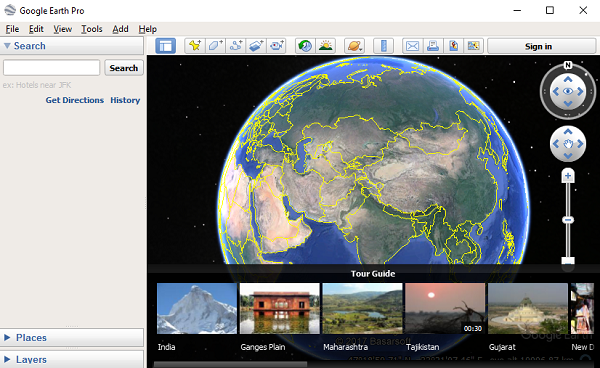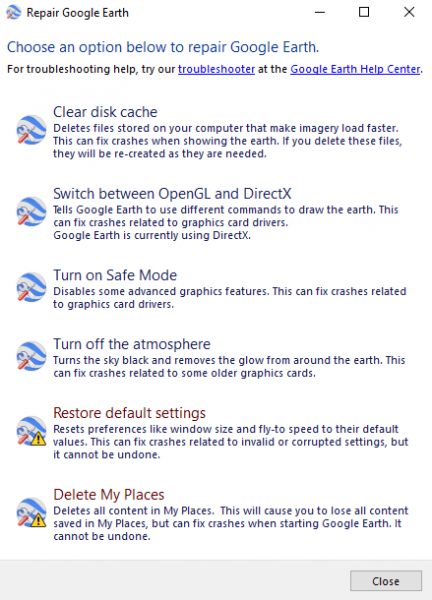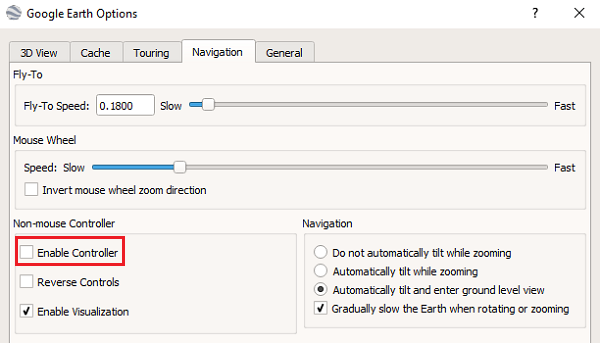Earlier this year, Google Earth, the handiest of all applications finally became accessible on a browser and paved new avenues for virtual geographical explorations. Google Earth is probably the most important and widely used app in its category and is a necessity in almost every work sector. But at times this tool is known to cause problems – so if you are facing issues with Google Earth, try some of these suggestions and see if anything here helps you.

Google Earth Pro, which is basically the desktop version of the application – is essentially gearing up to be the most crucial of web applications, considering its usage in creating important maps, computing distances, and areas, visualizing and manipulating GIS data in desktop devices. But Google Earth Pro can sometimes face several issues while running, and several users worldwide have often complained. From freezing to not loading, the app often faces issues in Windows 11/10.
What are the issues?
In Windows 11/10 for instance, Google Earth Pro often freezes, runs blurry, or crashes after installation. Here are some of the most common issues faced by Windows users.
- Not running at all – Google Earth users sometimes complain that it just would not load, start or even install on Windows 10. They have also reported that the application would not even open in their systems.
- No response – Google Earth Pro sometimes does not respond to commands in Windows 10. Though you can fix some issues with the proper solutions, if you know them, it is obviously very inconvenient if the application stops running or does just stops working altogether, in the middle of work.
- Street view is not working – Sometimes certain Google Earth features don’t run at all, like Street view, which is one of the most crucial functions, and is even used internationally for military operations.
- Google Earth Pro stopped altogether – Google Earth Pro can suddenly crash or freeze or just stop working.
What can you do?
There are, of course, different solutions for different issues, and you must take note of them all if you’ve been facing issues with Google Earth on Windows 10.
- Run it in Compatibility Mode
- Open and Repair Tool
- Clear cache and Reset its settings
- Use an older version of Google Earth
- Re-create shortcut and see
- Update/Rollback NVIDIA drivers.
Google Earth not working, crashes or freezes on Windows PC
If Google Earth is not opening at all, you should first try running it in the Compatibility Mode. You could also try opening it in Safe Mode. If that does not help, try the following suggestions:
1] If Google Earth crashes, run Repair Tool
Run their Troubleshooter/Repair Tool and see. Clearing your cache is probably the next best bet if your Google Earth Pro stops working. Here’s what you do – Open Google Earth Pro and go to the drop-down menu at the top. Click Help and then Launch Repair Tool.
The Repair Tool window and the Google Earth Pro window are separate. If you have managed to get Google Earth Pro running and have the Repair Tool window open, you have to close the GE Pro window before you do the fixes in the Repair Tool window.
If you cannot open Google Earth, you can still open its Repair Tool via its Program folder. Open Run box, paste C:\Program Files\Google\Google Earth Pro\client\repair_tool.exe in the box and hit Enter. If you have the 32-bit version of GE Pro, use “C:\Program Files (x86)\Google\Google Earth Pro\client\repair_tool.exe” instead. That should open the tool.
2] Try installing the older version of Google Earth
Re-installing is always an option when Google Earth Pro is not working on Windows 10. Install the application again and see if it works. Re-installing usually fixes corrupted files, in most cases, so try that first.
If reinstalling doesn’t work, try installing the older version of Google Earth. Previous versions can be downloaded from here.
3] How can re-creating a shortcut help?
Several users have reported that they are unable to install Google Earth Pro on their Windows systems. When they try to install the program, an error 1603 appears, and installation stops right away or the screen crashes.
The 1603 error simply means the application is already installed on your computer, so you can’t do it again. This is experienced by Windows users because, during the update process, Google Earth shortcuts from Desktop and Start Menu have been removed. In that case, you just have to create a shortcut again.
4] Use older NVIDIA drivers
Sometimes even the latest drivers aren’t completely compatible with certain software. If Google Earth is not working in Windows you might want to try switching back to the older version of NVIDIA drivers.
Press WinKey+X to open Win+X menu and select Device Manager from the list that appears. When Device Manager opens, locate your graphics card, right-click, and Uninstall device. When the confirmation dialog box appears, choose to Delete the driver software for this device and click on Uninstall.
After the driver is uninstalled, you need to download the older version of the Nvidia driver. In case, you have questions about that, go through our tutorial on how to update graphics card driver. After you install the older driver version, your problem should be fixed.
5] How can using integrated graphics help?
Integrated graphics use a portion of a computer’s RAM instead of their own dedicated memory. If Google Earth is not working on Windows, the problem might be the dedicated graphics card. You need to switch to integrated graphics while using Google Earth to fix this particular issue.
Here’s how you do it:
Navigate to Google Earth’s installation directory and locate Google Earth’s .exe file and right-click it. Then, you can choose the desired graphics card from the menu. If this works, you could set your integrated graphics as a default Google Earth Pro adapter.
Just go to the left pane under 3D Settings and select Manage 3D settings. In the right pane, select Program Settings tab, select Google Earth from the menu. Now set your integrated graphics as the default adapter by changing the settings below.
6] Ever noticed Google Earth spinning?
Have you ever experienced the Google Earth globe spinning? This is a common issue and happens if your controller is not calibrated. So, if you’re using a controller, follow the manual on how to calibrate your controller.
If you’re not using a controller, follow these steps:
Open Google Earth. Click Tools, then Options and then Navigation. Then, uncheck Enable Controller. 
Most people forget to uncheck the controller, but please remember that it will not work if you do.
7] How to fix blurry images on Google Earth
In case any image has not streamed completely in Google Earth Pro, you might see a message saying, “Won’t have high-resolution imagery for that area.” Here’s how you can fix it:
Verify that you’re not blocking the imagery with an overlay – turn off layers in your Places panel and then clear the cache.
Windows: Go to Google Earth Pro and then Preferences and then Cache and then Clear disk cache.
8] Boost Google Earth performance
You can boost performance by adjusting the memory or disk cache size as follows:
To increase memory or disk cache. open Google Earth, click Tools and then Options. Next, click Cache. Now in the “Memory Cache Size” field, enter a value. Google Earth automatically limits the size according to the physical memory available on your PC. Next, in the “Disk Cache Size” field, enter a number below 2000.
9] Recover disk space
To recover some disk space from the Google Earth folders, open Google Earth > Click File > Server Sign Out. Click Tools and then Options. Finally, click Cache and then Clear disk cache.
I hope some of these tips help you make Google Earth perform better.